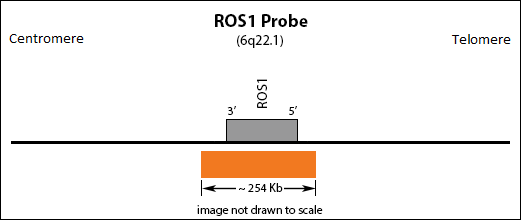ROS1 FISH Probe
The ROS1 proto-oncogene encodes a protein with tyrosine kinase activity. This protein is highly expressed in several tumor types. The protein may function as a growth or differentiation factor receptor. Chromosomal rearrangements involving the ROS1 gene were originally described in glioblastomas. More recently, ROS1 rearrangements have been identified as a potential "driver" mutation in non-small cell lung cancer and cholangiocarcinoma. Empire Genomics has developed a custom ROS1 probe which can be used to detect/confirm a rearrangement of the ROS1 gene. The probe comes labeled in orange, and you may also choose to customize the probe to meet your needs.

** This product is for in vitro and research use only. This product is not intended for diagnostic use.

| SKU | Test Kits | Buffer | Dye Color | Order Now |
|---|---|---|---|---|
| ROS1-20-OR (Standard Design) | 20 (40 μL) | 200 μL |

|
|
| ROS1-20-RE | 20 (40 μL) | 200 μL |

|
|
| ROS1-20-AQ | 20 (40 μL) | 200 μL |

|
|
| ROS1-20-GR | 20 (40 μL) | 200 μL |

|
|
| ROS1-20-GO | 20 (40 μL) | 200 μL |

|
Gene Summary
This proto-oncogene, highly-expressed in a variety of tumor cell lines, belongs to the sevenless subfamily of tyrosine kinase insulin receptor genes. The protein encoded by this gene is a type I integral membrane protein with tyrosine kinase activity. The protein may function as a growth or differentiation factor receptor. [provided by RefSeq, Jul 2008]
Gene Details
Gene Symbol: ROS1
Gene Name: ROS Proto-oncogene 1, Receptor Tyrosine Kinase
Chromosome: CHR6: 117609529-117747018
Locus: 6q22.1
FISH Probe Protocols
| Protocol, Procedure, or Form Name | Last Modified | Download |
|---|